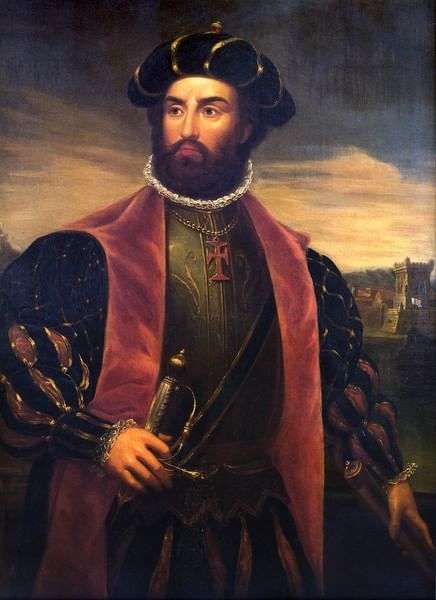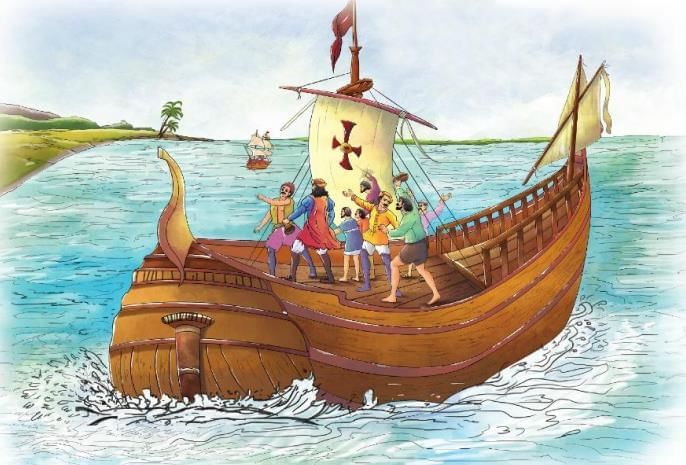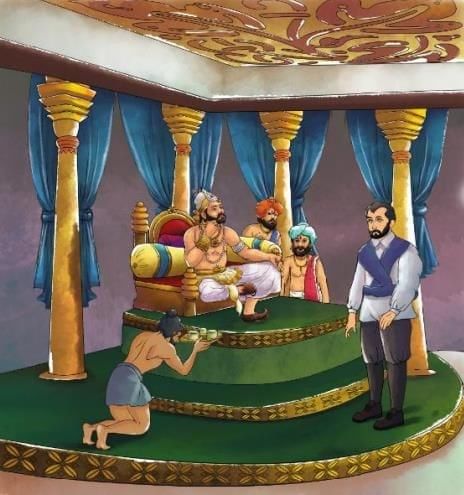Vasco da Gama in India Chapter Notes | English Class 4 ICSE PDF Download
| Table of contents |

|
| Introduction |

|
| Key Points |

|
| Explanation |

|
| Message |

|
Introduction
This chapter tells us about Vasco da Gama, a brave explorer from Portugal who was the first European to reach India by sea. Long ago, people in Europe loved the spices from India, and the king of Portugal, King Manuel I, wanted to find a sea route to get them. He chose Vasco da Gama to lead a big journey that started in 1497. After a long trip of about a year, Vasco reached India in 1498. The story shares exciting details about his adventure, especially the day he saw the Indian coast and met the people there. It also talks about how he planned to trade with the king of Calicut, known as the Zamorin.
 Vasco da Gama
Vasco da Gama
Key Points
This story is about:
- Vasco da Gama being the first European to sail to India in 1498.
- King Manuel I of Portugal sending Vasco to find spices for trade.
- Vasco starting his journey in July 1497, which took about a year.
- Vasco seeing land near Cananor first, then being guided to Calicut.
- Vasco meeting the Zamorin, the king of Calicut, to talk about trading spices.
- Vasco and his crew making up a story about a big fleet of ships to stay safe.
- Vasco’s men trading with local fishermen to share their story and connect with the Zamorin.
Explanation
Vasco da Gama’s journey began because the king of Portugal wanted to bring spices from India to Europe. The king prepared everything carefully and picked Vasco to lead the mission. Vasco started his sea trip in July 1497. After traveling for a long time, about a year, he finally arrived on the coast of India in 1498.
One morning, after sailing for nineteen days on the Indian Ocean, the person guiding the ship told Vasco they were close to India. The next day, everyone on the ship looked out eagerly and saw land. The sailors shouted with joy, and Vasco thanked God for their safe arrival. As they got closer, they saw a town with houses made of straw and many fishing boats. The people there were surprised to see the ships and came close to look.
At first, Vasco thought this town was Calicut, a famous city he had heard about with big buildings and riches. But the guide said it was Cananor, and Calicut was just twelve leagues away. That evening, Vasco talked with his experienced crew members about meeting the Zamorin, the king of Calicut, who controlled an important trading port.

Vasco wanted to go meet the king himself, but his crew advised him to be careful. They suggested asking for hostages to stay safe, as it was a custom in that region. They decided to tell the king that Portugal had sent a large group of fifty ships, but two got separated in a storm and were waiting for the others.
The next day, local people in boats came to see the ships. Vasco’s men traded with the fishermen, buying fish and sharing their story about the fleet. This news reached the Zamorin. For three days, they only traded with the fishermen. On the fourth day, a messenger from the Zamorin arrived with gifts and asked who they were and what they wanted.

Vasco sent one of his trusted men to answer. The messenger told the Zamorin that the Portuguese wanted peace and friendship, and they brought rich cloths, gold, and silver to trade for pepper and spices. The Zamorin agreed to fill their ships with spices, which made everyone on the ships very happy.
Message
The story teaches us about the importance of bravery and careful planning. Vasco da Gama showed courage by traveling a long distance to a new land. It also shows how talking and trading with others can build friendship, like how Vasco made peace with the Zamorin. We learn that working together and being smart can help us achieve big goals.
New Words with Meanings
- Expedition: A planned trip with a special purpose.
- Voyage: A long trip by sea.
- Pilot: The person who steers the ship.
- Deck: The floor of a ship.
- Maintop: A platform near the top of the ship’s main mast.
- Quarterdeck: The upper part of the ship where officers stay.
- Behold: An old way to say "look."
- Bay: A part of the sea surrounded by land on three sides.
- Thatched: Made with a roof of straw or hay.
- At anchor: When a ship stops in the sea using an anchor.
- Splendour: Something very grand and beautiful.
- League: An old way to measure distance.
- Hostage: A person kept to ensure safety or agreement.
- Fleet: A group of ships.
- Native: A person born in a certain place.
- Fishing smack: A small fishing boat.
- Sling: A tool like a catapult.
- Hilt: The handle of a sword.
- Interpreter: A person who translates languages.
- Cargo: Goods carried by a ship.
- Prospect: The chance of something good happening.
- Goodwill: Friendly feelings between people.
FAQs on Vasco da Gama in India Chapter Notes - English Class 4 ICSE
| 1. Who was Vasco da Gama and why is he significant in Indian history? |  |
| 2. What were the main objectives of Vasco da Gama's voyages to India? |  |
| 3. What were the consequences of Vasco da Gama's arrival in India for the local population? |  |
| 4. How did Vasco da Gama's voyages impact global trade? |  |
| 5. What was the legacy of Vasco da Gama's explorations in the context of European colonialism? |  |














